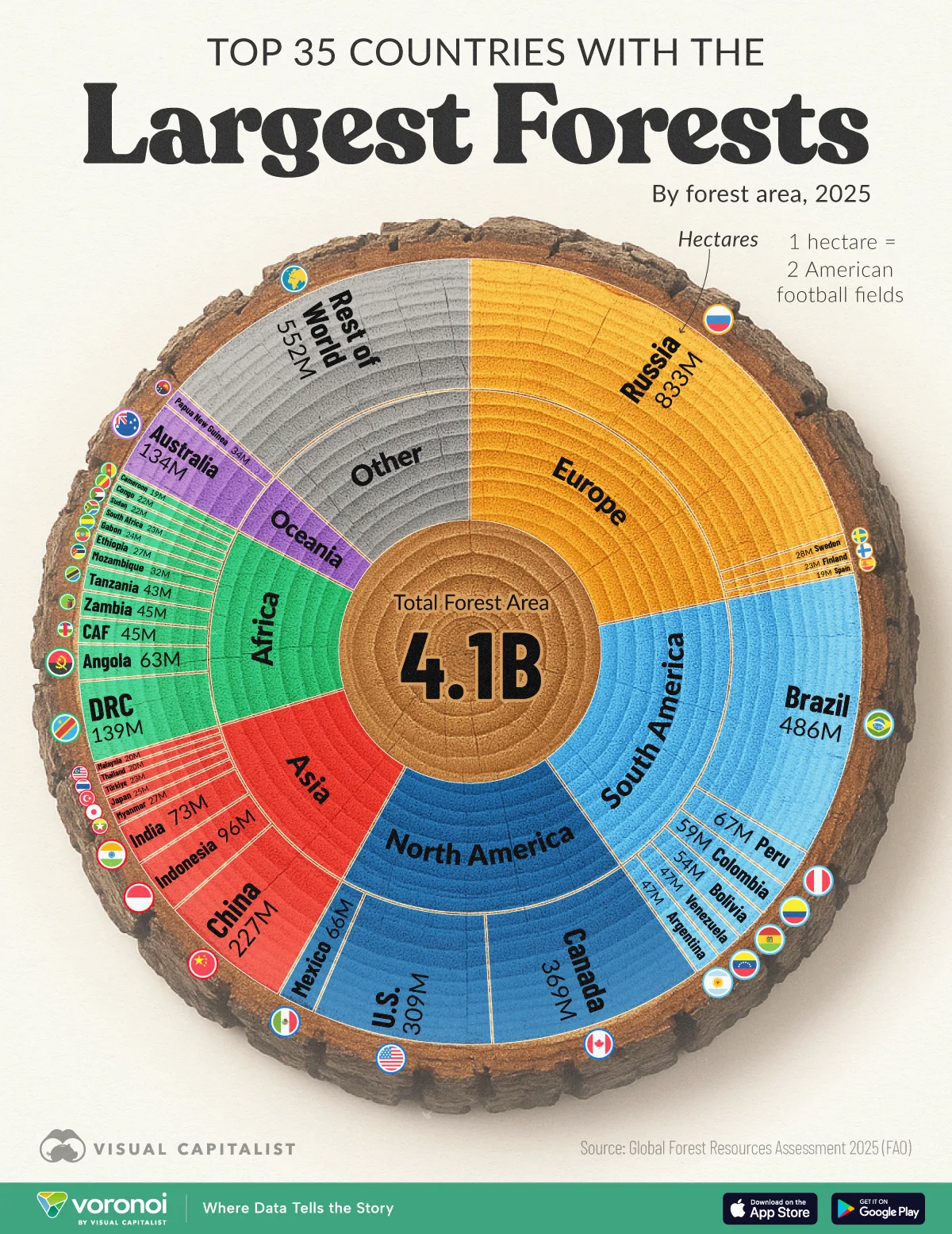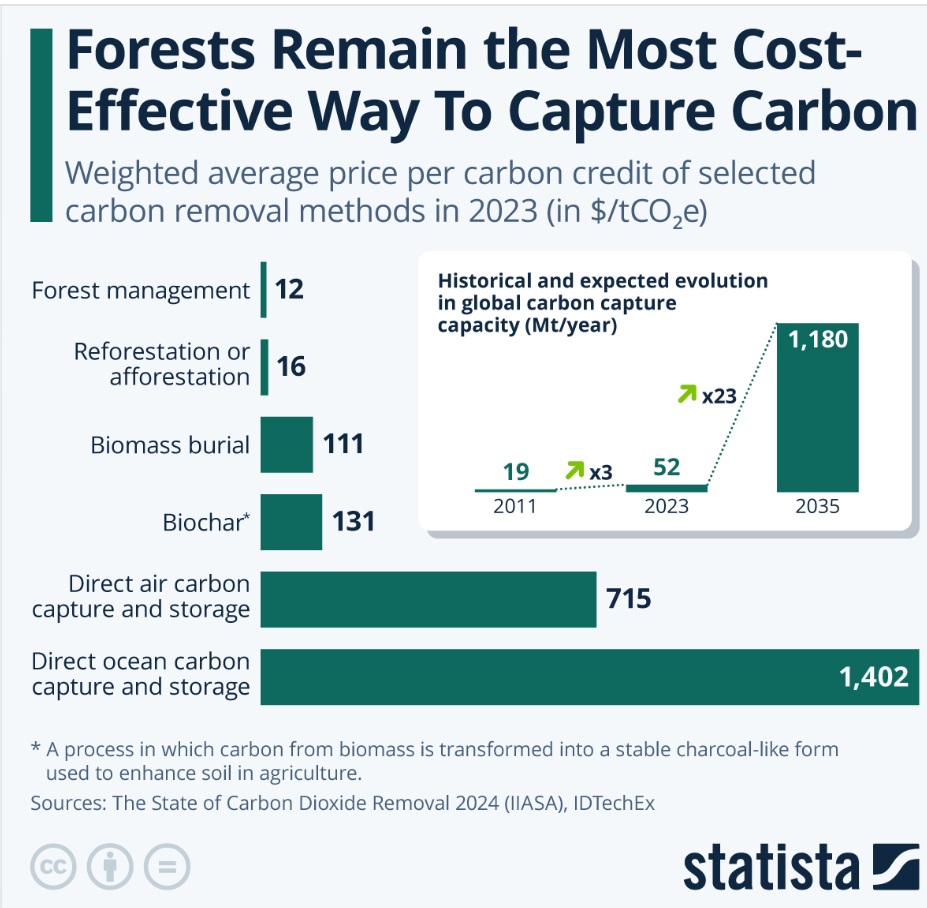Economy and business
Where Are the World’s Forests? The 2025 Ranking and Why It (Economically) Matters.
We often hear talk of complex and expensive “carbon capture” technologies. Yet, the most efficient, economically advantageous, and energetically sound technology for absorbing CO2 has always existed: forests.
But where are these fundamental “lungs” of the planet located? A new report from the FAO, the Global Forest Resources Assessment 2025, provides us with an updated map and some data that are food for thought, not only environmentally but also economically and geopolitically.Thi Infographic is from Visual Capitalist

A Green “Oligopoly”: Half the World in 5 Countries
The first thing that stands out is the extreme concentration. We aren’t talking about micro-nations, but true giants that manage, for better or worse, the planet’s climate health.
50% of all the world’s forests are located in just five countries.
Russia alone holds one-fifth of the global forests. If we add Brazil and Canada, we reach 40%. With the United States and China, that figure hits 50%. This isn’t just a statistic; it’s a geopolitical fact. It means that decisions made in Moscow, Brasilia, Ottawa, Washington, and Beijing can influence the global climate more than a thousand international conferences.
Here is the data in detail:
| Rank | Country | Forest Area (Million Hectares, 2025) | Share of World Total |
| 1 | 🇷🇺 Russia | 833 | 20.1% |
| 2 | 🇧🇷 Brazil | 486 | 11.7% |
| 3 | 🇨🇦 Canada | 369 | 8.9% |
| 4 | 🇺🇸 U.S. | 309 | 7.5% |
| 5 | 🇨🇳 China | 227 | 5.5% |
The Tropical Tension: Growth vs. Conservation
Continuing down the list, we find the other green powers: the Democratic Republic of the Congo (139M ha), Australia (134M ha), Indonesia (96M ha), and Peru (67M ha).
This is where “tropical tension” comes into play. The equatorial forests, like the Amazon (Brazil/Peru) or the Congo Basin (DRC), are the most vital for biodiversity and carbon storage. The Amazon alone stores roughly a quarter of all land-based carbon.
However, these countries are also “hotspots” for mining, intensive agriculture, and logging. It is the classic, and unresolved, tension between the need for domestic economic growth and the necessity of global conservation.
Policy Works: The Reforestation Cases
It’s not all bad news. The data shows that active reforestation policies can work.
-
China is in fifth place not by chance, but thanks to decades of large-scale initiatives like the “Great Green Wall.”
-
In Europe, Sweden and Finland (both with around 28 million hectares) demonstrate how a timber industry can coexist with sustainable management.
-
Türkiye and Spain, further down the list, have reversed 20th-century declines thanks to massive reforestation programs.
These examples show that policy tools—like afforestation incentives and strict harvest limits—can produce results.
However, experts are clear: reforestation (planting new trees) is useful, but it can never replace the conservation of primary forests (the original, untouched ones).
In an era where we discuss giant, expensive “CO2 vacuum cleaners,” perhaps we should remember that the most efficient, as noted by Statista, economical, and proven solution already grows on its own from the ground. We simply need to protect it.

Questions and Answers
- Which countries have the most of the world’s forests?
The vast majority of forests are concentrated in just a few countries. Russia leads with 833 million hectares, or 20% of the world’s total. It is followed by Brazil (11.7%) and Canada (8.9%). These three countries alone control 40% of global forests. If you add the United States (7.5%) and China (5.5%), you reach 50%. This means half of the world’s forest heritage is managed by just five nations.
- Why does it matter that a few nations control most of the forests?
It is a crucial geopolitical factor. Forests are the planet’s primary “carbon sinks”: they absorb CO2 and stabilize the climate. The fact that they are concentrated in a few nations means that the domestic policies of Russia, Brazil, or the DRC (for tropical forests) have a global impact. A decision by Brasilia on the Amazon or by Moscow on the Siberian taiga affects everyone’s climate, highlighting a strong tension between national sovereignty and global necessity.
- Is reforestation (planting new trees) enough to solve the CO2 problem?
No, it is not enough, although it is a positive initiative. The report shows that countries like China have increased their forest area. However, scientists stress that “primary” (ancient and undisturbed) forests are far more effective at storing carbon and protecting biodiversity than planted forests. The priority remains protecting existing woodlands. Nonetheless, forests remain the most efficient and economical CO2 capture system available, superior to any artificial technology currently proposed.






